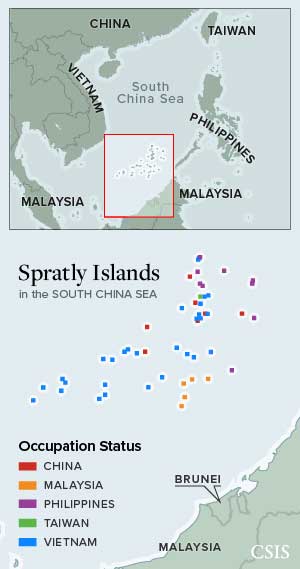
Unseen fishing activity. Maritime militias in the Spratlys. Fishers have often been overlooked in the South China Sea disputes. CSIS, in cooperation with Vulcan, Inc., unveils a worrying narrative about the impact fishers and their fleets have in the region.
The South China Sea has emerged as one of the most dangerous flashpoints in the Indo-Pacific over the last decade. With China’s expansion and militarization of its holdings in the disputed Spratly Islands from late 2013, tensions have escalated rapidly.
The South China Sea is home to two sets of disputes.
One is over sovereignty. China, Taiwan, Brunei, Malaysia, the Philippines, and Vietnam claim various islands, rocks, and reefs around the sea.
The other involves those parties and Indonesia. The dispute is over how to divide the sea itself.
Southeast Asian claimants assert rights to overlapping maritime zones under international law.
China and Taiwan, however, claim ill-defined rights over a vast area bordered by the so-called Nine-Dash Line.
The security implications of these disputes receive significant attention, and the disputants’ navies, air forces, and coast guards are studied closely to assess the balance of power and risk of escalation. But too little attention has focused on another key set of actors in the South China Sea—the fishers who serve on the frontlines of this contest. Those fishers face a dire threat to their livelihoods and food security as the South China Sea fisheries teeter on the brink of collapse.
more than 50% of the fishing vessels in the world are estimated to operate in the South China Sea.
The South China Sea accounted for 12 percent of global fish catch in 2015, and more than half of the fishing vessels in the world are estimated to operate there. Its fisheries officially employ around 3.7 million people and unofficially many more. But the South China Sea has been dangerously overfished. Total stocks have been depleted by 70-95 percent since the 1950s, and catch rates have declined by 66-75 percent over the last 20 years.
Coral reefs, on which much of these fish depend, have been declining by 16 percent per decade. And that decline rapidly accelerated over the last five years in which giant clam harvesting, dredging, and artificial island building have severely damaged or destroyed over 40,000 acres, or about 160 square kilometers, of reefs.
